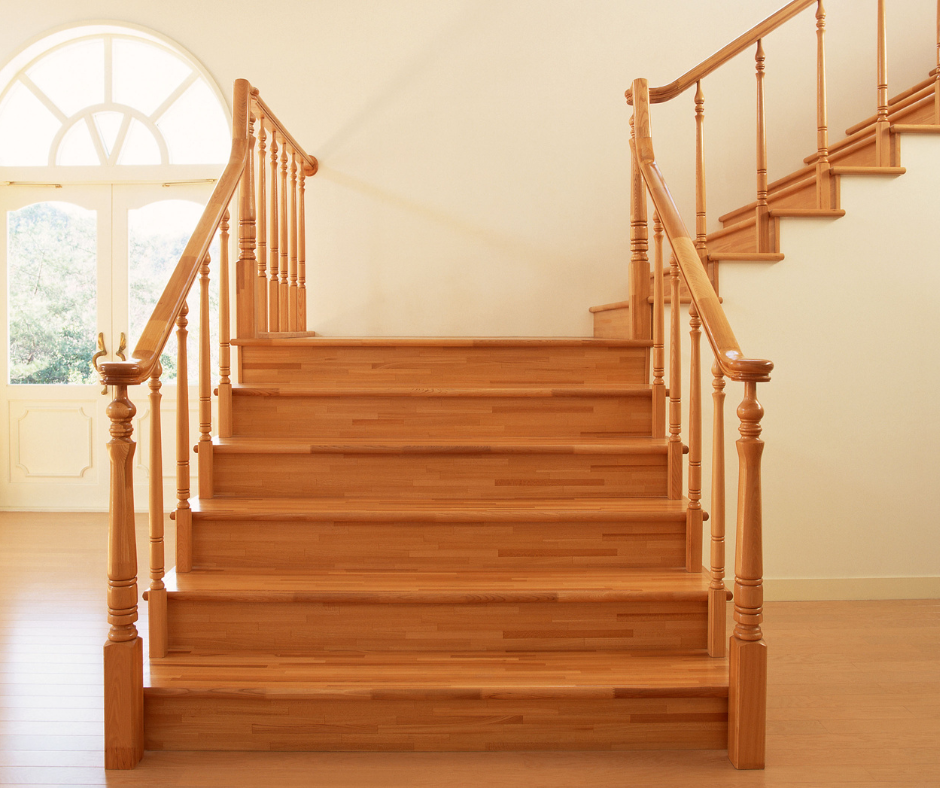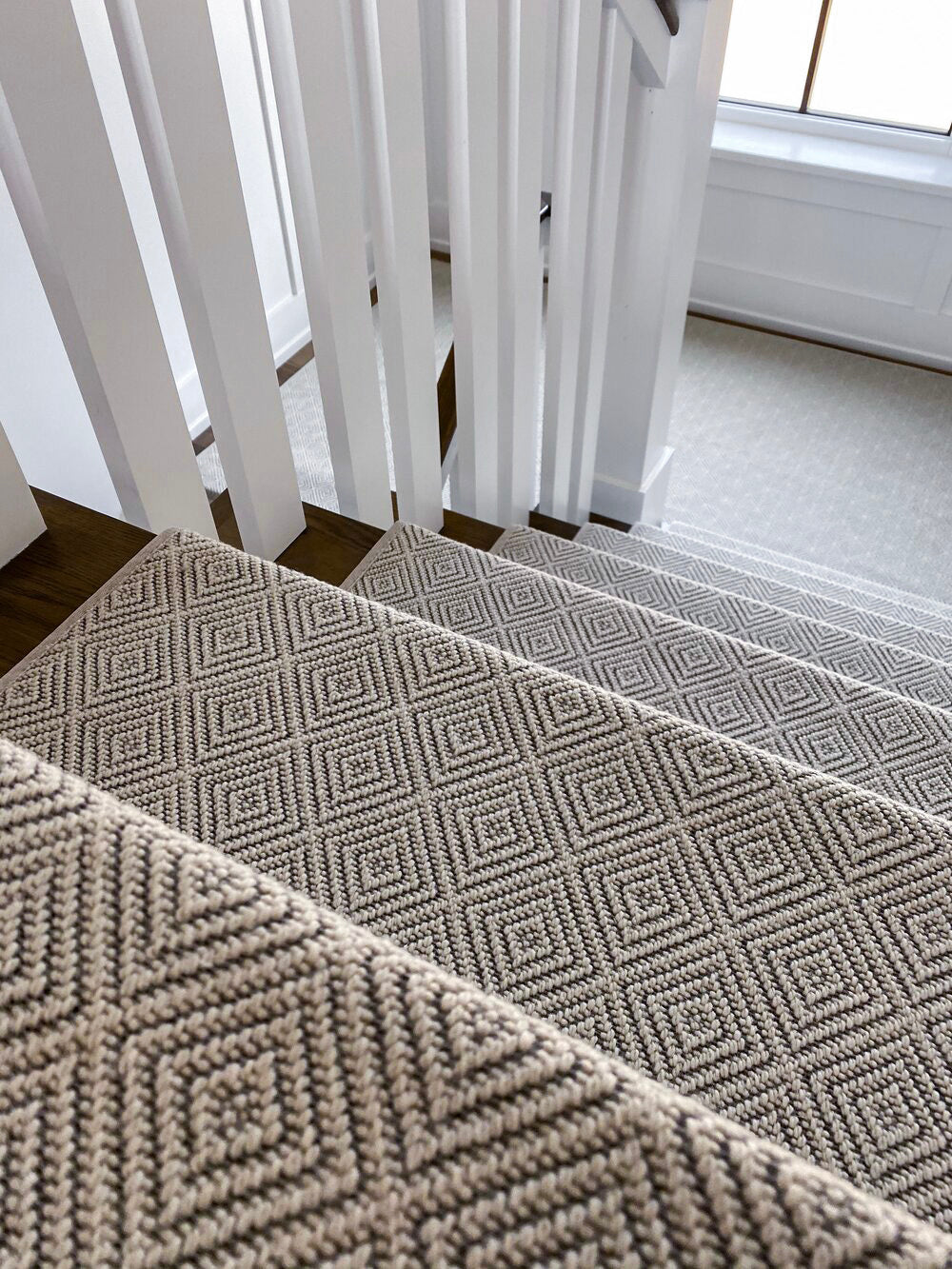Choosing the right staircase design isn’t just about looks — it affects how your entire home feels and functions. So, what are the types of stairs? They include straight, quarter turn, half turn, spiral, curved, winder, bifurcated, circular, ladder, and floating stairs.
In this guide, you’ll learn how each stair type works, where it fits best, and what makes it safe or stylish. We’ll also show you how carpet stair treads can add safety, comfort, and charm to nearly every stair design. By the end, you’ll be ready to make confident choices that match your home and your family’s needs.
Straight Stairs
Straight stairs are the most common and straightforward design, consisting of a single linear flight without any change in direction. They are easy to construct and navigate, making them a popular choice for many homes. However, they require a significant amount of linear space and may not offer the visual interest or space-saving benefits of other designs.
Quarter Turn Stairs
Also known as L-shaped stairs, quarter turn stairs incorporate a 90-degree turn, typically achieved with a landing. This design is ideal for corners and offers a compact solution without compromising on style. They provide a visual barrier between floors, adding privacy and can be safer due to the landing breaking the flight. Quarter turn stairs are versatile and can be adapted to various design styles, from traditional to modern.
Half Turn Stairs
Half turn stairs, or U-shaped stairs, make a 180-degree turn, consisting of two flights running in opposite directions with a landing between them. This design is efficient for buildings with limited space and offers a comfortable transition between floors. The landing provides a resting point, enhancing safety and ease of use.
Spiral Stairs
Spiral stairs wind around a central pole, forming a compact and visually striking design. They are space-saving solutions, often used in areas with limited room. However, they can be more challenging to navigate, especially for those with mobility concerns, and may not be suitable for high-traffic areas.
Curved Stairs
Curved stairs follow a helical arc, offering a graceful and elegant appearance. Unlike spiral stairs, they don't have a central pole and are often used in grand entrances or foyers to make a statement. Their construction is more complex, requiring precise engineering and craftsmanship.
Winder Stairs
Winder stairs are similar to quarter turn stairs but replace the landing with wedge-shaped steps. This design saves space and adds a unique visual element but may be less comfortable to use due to the varying tread sizes. They are often found in older homes and can add character to a space.
Bifurcated Stairs
Bifurcated stairs feature a single wide flight that splits into two narrower flights in opposite directions. This grand design is often found in large buildings and adds a dramatic architectural element. They require ample space and are typically used in formal settings.
Circular Stairs
Circular stairs form a continuous arc, similar to curved stairs but typically more compact. They offer a smooth transition between floors and are often used in modern architectural designs. Their elegant appearance can enhance the aesthetic appeal of a home.
Ladder Stairs
Ladder stairs are steep and narrow, resembling a ladder. They are used in spaces where traditional stairs can't fit, such as lofts or attics. While space-efficient, they can be challenging to climb and are not suitable for everyone.
Floating Stairs
Floating stairs have treads attached to the wall with no visible support underneath, creating a minimalist and modern look. They require precise engineering and are often used in contemporary designs. While visually appealing, they may not be the best choice for homes with young children or elderly residents due to safety concerns.
Why Stair Type Matters in Home Design
The type of staircase chosen can significantly impact the overall design and functionality of a home. For instance, straight stairs offer a clean, modern look but require more space, while spiral or quarter turn stairs can save space and add architectural interest. The choice of staircase can also affect the flow of movement within the home and the amount of natural light that reaches different areas.
Best Stair Types for Small Spaces
In homes with limited space, certain stair designs can help maximize the available area. Spiral, winder, and ladder stairs are compact options that can fit into tight spaces. Quarter turn stairs are also a good choice, as they can be tucked into corners and provide a more gradual ascent, making them safer and more comfortable to use.
Stair Types by Safety Level
Safety is a crucial consideration when choosing a staircase, especially in homes with children, elderly residents, or individuals with mobility issues. Straight stairs are simple but can be hazardous due to their length and lack of resting points.
Quarter turn and half turn stairs offer landings that break up the flight, providing rest areas and reducing the risk of falls. Winder and spiral stairs can be more challenging to navigate and may not be suitable for everyone.
Materials Best Suited for Each Stair Type
The materials used in staircase construction can affect both the appearance and functionality of the stairs. Wood is a popular choice for many stair types due to its warmth and versatility.
Metal and glass are often used in modern designs like floating or spiral stairs, offering a sleek, contemporary look. Carpet can be added to various stair types to enhance safety and comfort, particularly in homes with children or elderly residents.
How to Choose the Right Stair Type for Your Home
Selecting the appropriate staircase involves considering several factors, including available space, aesthetic preferences, budget, and the specific needs of household members. For example, a family with young children may prioritize safety and opt for quarter turn or half turn stairs with landings, while someone seeking a modern, minimalist look might choose floating stairs. Consulting with a professional can help ensure that the chosen staircase meets all functional and design requirements.
Frequently Asked Questions About Stair Types
What is the difference between quarter turn and winder stairs?
Quarter turn stairs include a landing at the 90-degree turn, while winder stairs use wedge-shaped steps to make the turn without a landing.
Are spiral stairs safe for families?
Spiral stairs can be safe if built to code and equipped with handrails, but they may be challenging for young children or elderly individuals to navigate.
What is the most space-efficient stair design?
Spiral and ladder stairs are among the most space-efficient designs, making them suitable for small or confined areas.
Can I install a different stair type during a renovation?
Yes, but it's essential to consult with a professional to ensure the new design complies with building codes and fits the existing space.
Stepping It Up
Choosing the right staircase is a vital aspect of home design that affects both aesthetics and functionality. By understanding the various types of stairs and considering factors like space, safety, and style, homeowners can make informed decisions that enhance their living environment.
Ready to Style Your Stairs the Smart Way?
Now that you know what types of stairs work best for your home, it’s time to take that next step — safely and stylishly. Whether you’ve got a quarter turn staircase or a classic straight set, Oak Valley Designs has the perfect stair treads to match your needs and your style.
Made in the USA, easy to install, and crafted with comfort and care — let us help you make your staircase safer and more beautiful.
Explore our DIY-friendly stair tread collection today.
-
Website: https://oakvalleydesigns.com/
-
Phone: 706.331.0315
-
Email: info@oakvalleydesigns.com
-
Address: 30 River Ct SW Bldg E Cartersville, Ga 30120




